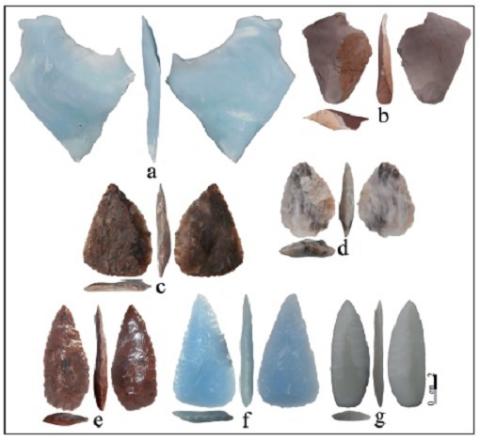Hugo Nami
2 019
Cuadernos del Instituto Nacional de Antropología y Pensamiento Latinoamericano 28 (1): 64-87 (2019)
En el sudeste de Sudamérica, particularmente al sur de Brasil, Uruguay y este de las provincias mesopotámicas de Argentina, el registro arqueológico de piedra tallada se caracteriza por su riqueza y variedad. Allí, un grupo de puntas de proyectil mostró que además de secciones biconvexas, tienen helicoidales y otras variedades relacionadas. Con la meta de conocer, comprender y dilucidar diversas cuestiones técnicas acerca de su manufactura, se efectuó un experimento replicativo. La experimentación permitió apreciar y verificar que aunque el producto final se concibe tratando de mantener el contorno simétrico, para obtenerlas es necesario planearlas y concebirlas de una manera distinta, pues en los limbos se necesita generar bordes que no están alineados ni centrados con respecto al plano horizontal. También se observó que hay una significativa diferencia cuando se comienza desde lascas cuyo tamaño no es mucho mayor que el producto terminado y se talla mayormente por presión, de aquellas conformadas previamente por adelgazamiento bifacial usando percusión. La razón principal es que en este último caso, el espesor final y la uniformidad de las secciones prácticamente se obtienen por este procedimiento; mientras que, en las lascas –especialmente en las de rocas silíceas– el logro de la biconvexidad es un poco más dificultoso. Se sugiere que su presencia en el SE sudamericano corresponde a una receta de fabricación existente en el conocimiento tecnológico tradicional de los cazadores-recolectores que las confeccionaban.
In southeastern South America, particularly south of Brazil, Uruguay and east of the Mesopotamian provinces of Argentina, the archaeological record of flaked stone is characterized by its richness and variety. There, a group of projectile points showed that in addition to biconvex sections, they have helicoidal and other related varieties. With the goal of knowing, understanding and elucidating various technical questions about its manufacture, a replicative experiment was carried out. The experimentation allowed to appreciate and verify that although the final product is conceived trying to maintain the symmetrical contour, to obtain them it is necessary to plan and conceive them in a different way, since in the blades it is necessary to generate edges that are not aligned or centered with respect to the horizontal plane. It was also observed that there is a significant difference when starting from flakes whose size is not much larger than the finished product and is flaked mostly by pressure, of those previously formed by bifacial thinning using percussion. The main reason is that in the latter case, the final thickness and the uniformity of the sections are practically obtained by this procedure; whereas, in the flakes –especially in those of siliceous rocks– the achievement of the biconvexity is a little more difficult. It is suggested that their presence in the South American SE corresponds to a recipe for fabrication that existed in the traditional technological knowledge of the hunter-gatherers who made them.

